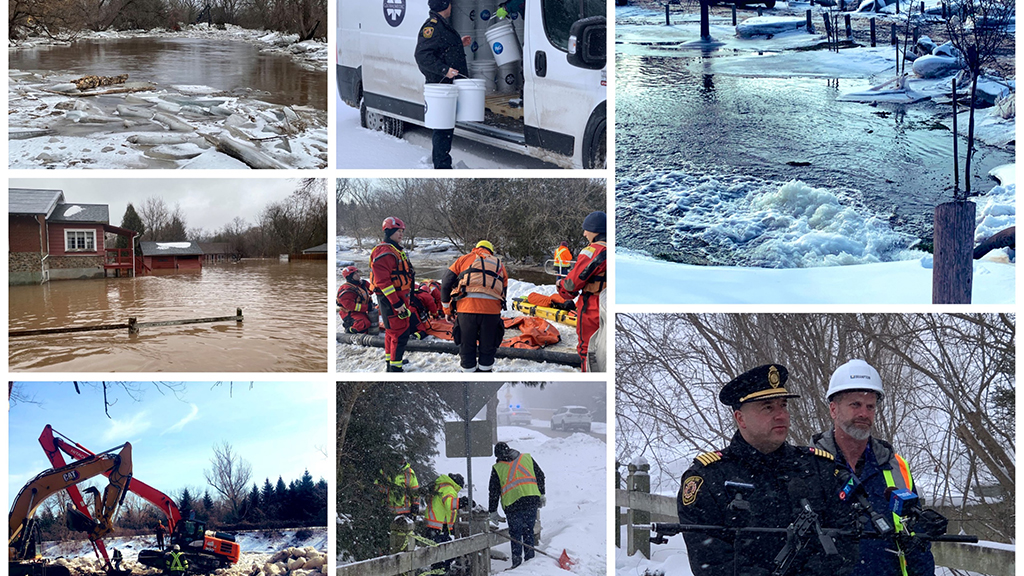As weather patterns change and climate emergencies become more common, so too does the planning and response that municipalities have for them.
“The weather has changed in the last 10 years. It’s changed in the last 20 years, 30 years, so what we used to plan for…is not necessarily what we plan for now,” Rick Bernard, manager of emergency management with the City of Brampton, told those in attendance at the Good Roads conference session Which Comes First: Emergency Preparedness or Disaster Recovery.
Bernard spoke about an emergency that occurred last February in the city, an ice jam that caused widespread flooding in the neighbourhood of Churchville.
In Ontario, all 444 municipalities need to have a hazard identification risk assessment list that identifies threats and hazards the community may face and they are prioritized.
“What we’ve seen in the last 20 years is that those change,” he noted. “What we plan for now is things that happen much more often…a lot of the weather events. Top of our list in Brampton and a lot of municipalities is freezing rain. Another big one is windstorms — winds are very damaging, just as much as floods can be and even snowstorms.”
Michael Papadacos, director of asset management and capital planning with the City of Peterborough, discussed two weather emergencies: the massive flood in 2004 and the derecho last May.
“The thunderstorms that were in the forecast turned very scary to the point where a whole subdivision where we had new construction underway got knocked down. Throughout the community we had lost over 800 public street trees alone and, as you can imagine, there was a massive resulting impact on our electrical grid,” he said of the devastation caused last May. “It was very hard to get around. It was very hard for us even as a municipality to mobilize our emergency response. It was on the long weekend so a lot of folks were not around.”
The City of Ottawa was also in the path of the derecho last May.
“(It) lasted for several minutes with some downbursts reaching 100 km/h causing devastating impacts across the entire city with damages such as massive power outages,” recalled Jake Gravelle, area manager for roads services and public works with the City of Ottawa. “About 50 per cent of the customer base within Ottawa was without power for several days and weeks, loss of the tree canopy, damage to buildings and infrastructure…dozens of roadways and emergency routes were blocked by fallen trees.”
Bernard and Gravelle agreed it’s a good idea for municipalities to take an all-hazards approach when planning for emergencies.
“A lot of the impacts, no matter what the emergency is, will be very much the same,” Bernard said. “You will have displaced residents, you may have to put together an evacuation centre, you will have to have some sort of crisis communication plan to implement.”
In terms of what has changed, Papadacos said the city learned a lot after the 2004 flood and subsequent events.
“The awareness of the intensity and the frequency of these events has become greater as a result of the changing climate and the changing weather patterns,” he noted.
“It did set in motion a lot more proactive planning around our climate resilience and climate adaptation efforts and put us in a bit of a better position now.
“It kicked off our Flood Protection Master Plan…It also encouraged council to create dedicated funding for flood reduction and resilience efforts.”
“A lot of the things that have really changed in more recent years, what we’ve seen is that people are more willing to undertake these types of investments because they have lived through the consequences of not doing so,” he added.
The windstorm last year brought into focus that municipalities are always preparing for the last crisis, Papadacos pointed out.
“We were pretty proactive on a lot of our floodplain efforts, but I think we were caught a little bit flat footed with the type of the event we had last year,” he noted. “It’s given us a fresh reminder of the importance of stepping back and making sure your emergency planning is looking at not just necessarily what the event is, flood or windstorm, but what are the types of impacts or the result, what are the support systems that you are going to lose and then what might that cause, how might you need to include that in the planning process.”
Papadacos explained there is a slightly different approach that is needed to plan for the longer, chronic emergencies such as climate change as opposed to the acute emergency of a single event.
“What has changed a little bit in recent years is the recognition that there is sort of a second, slow emergency planning that we need to also not lose sight of,” he said.
“We’re planning our infrastructure, looking at the risk and vulnerability of core assets, even looking at the changing numbers of freeze and thaw cycles and what that’s going to do to our pipes and roadways, what we might need to do in terms of planning for standards and how we implement those projects.”
Follow the author on Twitter @DCN_Angela



Recent Comments
comments for this post are closed